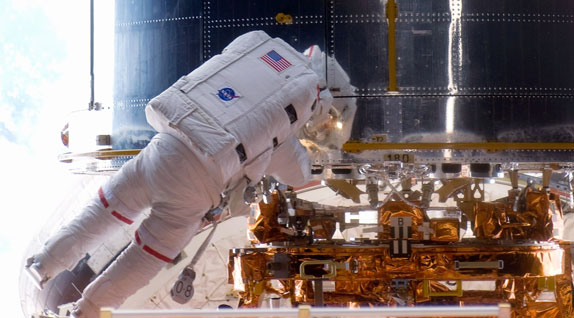 NASA via Getty Images
NASA via Getty Images
World News Desk
Learn the why behind the headlines.
Subscribe to the Real Truth for FREE news and analysis.
Subscribe NowAfter five days of repairs and upgrades, Space Shuttle Atlantis released the Hubble Space Telescope back into orbit, giving it five to 10 more years to investigate the mysteries of the universe.
The 19-year-old Hubble sailed back to its 350-mile path above Earth with a repaired spectrograph and wide-field camera, making the telescope the most powerful it has ever been—now able to peer to within 600 million years of the beginning of the universe.
“Today begins the second Hubble revolution,” senior project scientist David Leckrone told reporters in Houston after Atlantis began its return trip home.
The seven astronauts on the overwhelmingly successful mission restored power to a failed spectrograph (which aided scientists in discovering black holes) and installed a new one. Spacewalkers also fitted the orbiter with a new wide-field camera.
Against the blue glow of the earth, the shuttle crew also encountered many challenges during the five spacewalks. Some of the difficulties, relatively easy to fix on Earth, became herculean while traveling weightlessly at 17,000 miles an hour.
During the fourth walk, an astronaut discovered a bolt was stuck. He had to muscle it loose. Then, he removed 111 more screws, being sure none slipped through his bulky spacesuit gloves into space.
Over the years, the 43.5-foot-long Hubble has allowed man to examine dark energy, determine the age of the universe, witness the birth and death of stars, and glimpse about 800 million years into the universe’s past.
Hubble has also produced legendary images: the luminous spiraling arms of a galaxy, speckled with pinks and blues; star-nursery pillars of cool interstellar gas, glowing with ethereal greens; and the dark magentas of the Horsehead Nebula.
The telescope’s importance prompted Atlantis crew member John Grunsfeld to call it “arguably the most important scientific instrument ever created” (The New York Times).
This fifth and final mission to repair the telescope also restored it to a higher orbit, adding years to its mission time. Depending on solar activity, the space telescope will reenter Earth’s atmosphere between 2013 and 2020. NASA plans to launch Hubble’s successor, the James Webb Space Telescope, in 2013.
Hubble should be fully operational by the end of summer.
- Real Truth Magazine Articles
- SCIENCE & TECHNOLOGY
 How Man Will Conquer Space!
How Man Will Conquer Space!
More on Related Topics:
- How Social Media Became a Storefront for Deadly Fake Pills
- Cyberattacks on U.S. Utilities Surged 70 Percent This Year, Says Check Point
- A Robot Begins Removal of Melted Fuel from the Fukushima Nuclear Plant. It Could Take a Century
- Explainer: Why South Korea Is on High Alert over Deepfake Sex Crimes
- Older Americans Prepare Themselves for a World Altered by Artificial Intelligence


